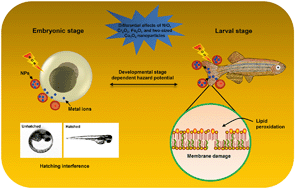Differential effects of metal oxide nanoparticles on zebrafish embryos and developing larvae†
Abstract
The differential effects and corresponding toxicity mechanisms of five metal oxide nanoparticles were investigated using zebrafish embryos and developing larvae. At the embryonic stage, hatching interference, the most apparent toxicity outcome, was mainly due to heavy metal ion shedding from the dissolvable NiO and Cr2O3 nanoparticles. The extent of biotic reactive oxygen species (ROS) generation by these metal oxide nanoparticles did not correlate with either the metal dissolution or the hatching interference. Differently, at the larval stage, the abiotic ROS generation capability was found to be closely related to the biotic ROS generation, glutathione depletion, lipid peroxidation, and larval skin damage. These results showed distinctly different toxicity profiles of the same nanoparticles in zebrafish at different developmental stages. While the dissolvable NiO and Cr2O3 showed higher hazard potential at the embryonic stage due to heavy metal ion shedding, Co3O4 of 30 nm size displayed a higher potency towards zebrafish larvae due to ROS generation and skin damage. This study demonstrated the importance of considering developmental stage differences while performing safety assessment as well as interpreting the hazard potential of nanoparticles using living organisms like zebrafish.



 Please wait while we load your content...
Please wait while we load your content...